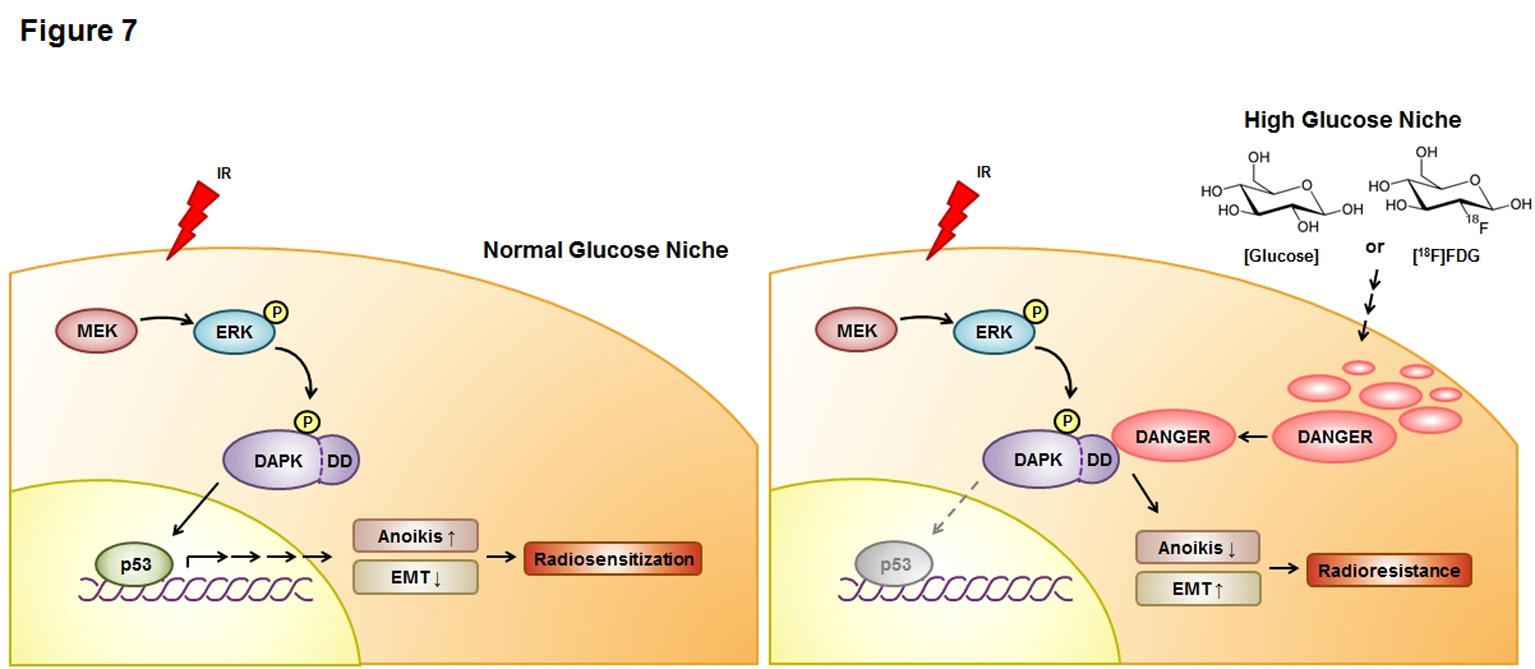글로벌 연구동향
방사선생물학
![[Oncotarget] DANGER is involved in high glucose-induced radioresistance through inhibiting DAPK-mediated anoikis in non-small cell lung cancer.](/enewspaper/upimages/admin_20160317182757_R.jpg) 2016년 03월호
2016년 03월호
[Oncotarget] DANGER is involved in high glucose-induced radioresistance through inhibiting DAPK-mediated anoikis in non-small cell lung cancer.부산대 / 윤부현*, 김완연*
- 출처
- Oncotarget
- 등재일
- 2016 Jan 12
- 저널이슈번호
- doi: 10.18632/oncotarget.6887. [Epub ahead of print]
- 내용

Abstract18F-labeled fluorodeoxyglucose (FDG) uptake during FDG positron emission tomography seems to reflect increased radioresistance. However, the exact molecular mechanism underlying high glucose (HG)-induced radioresistance is unclear. In the current study, we showed that ionizing radiation-induced activation of the MEK-ERK-DAPK-p53 signaling axis is required for anoikis (anchorage-dependent apoptosis) of non-small cell lung cancer (NSCLC) cells in normal glucose media. Phosphorylation of DAPK at Ser734 by ERK was essential for p53 transcriptional activity and radiosensitization. In HG media, overexpressed DANGER directly bound to the death domain of DAPK, thus inhibiting the catalytic activity of DAPK. In addition, inhibition of the DAPK-p53 signaling axis by DANGER promoted anoikis-resistance and epithelial-mesenchymal transition (EMT), resulting in radioresistance of HG-treated NSCLC cells. Notably, knockdown of DANGER enhanced anoikis, EMT inhibition, and radiosensitization in a mouse xenograft model of lung cancer. Taken together, our findings offered evidence that overexpression of DANGER and the subsequent inhibitory effect on DAPK kinase activity are critical responses that account for HG-induced radioresistance of NSCLC.
Author information
Kwon T1, Youn H2,3, Son B1, Kim D1, Seong KM4, Park S5, Kim W2,3, Youn B1,2,3.
1Department of Integrated Biological Science, Pusan National University, Busan, 609-735, Republic of Korea.
2Department of Biological Sciences, Pusan National University, Busan, 609-735, Republic of Korea.
3Nuclear Science Research Institute, Pusan National University, Busan, 609-735, Republic of Korea.
4National Radiation Emergency Medical Center, Korea Institute of Radiological & Medical Sciences, Seoul, 139-706, Republic of Korea.
5Department of Physics, Pusan National University, Busan, 609-735, Republic of Korea.
- 키워드
- DANGER; DAPK; anoikis; high glucose; radioresistance
- 연구소개
- 고농도의 포도당이 방사선저항성에 미치는 영향을 규명한 논문입니다. 비소세포폐암 세포에 방사선이 조사되면 MEK/ERK 신호에 의해 DAPK가 인산화되어 p53-의존적 anoikis를 유도하여 방사선에 의한 세포사멸이 일어나게 됩니다. 이 때 고농도의 포도당에 노출된 비소세포폐암 세포의 경우에는 DANGER가 과발현됩니다. 방사선 조사 시 ERK에 의한 인산화와는 무관하게 DAPK는 과발현된 DANGER와 결합을 하며, DAPK에 의한 anoikis 신호전달이 억제됩니다. 이러한 일련의 신호 과정을 통해 세포가 죽지 않고 전이능을 획득하여 방사선저항성을 나타내게 됩니다. 본 연구는 포도당이 축적된 환경이나 암 진단에 이용되는 FDG-PET에 의한 방사선 저항성 및 전이능 획득의 원인을 규명한 것으로, FDG-PET에 의한 방사선 치료효율 저하를 극복할 수 있는 과학적 근거가 될 수 있습니다.
- 덧글달기
- 이전글 [Oncotarget] GDF15 contributes to radiation-induced senescence through the ros-mediated p16 pathway in human endothelial cells.
- 다음글 [Oncotarget] Lanatoside C suppressed colorectal cancer cell growth by inducing mitochondrial dysfunction and increased radiation sensitivity by impairing DNA damage repair.







